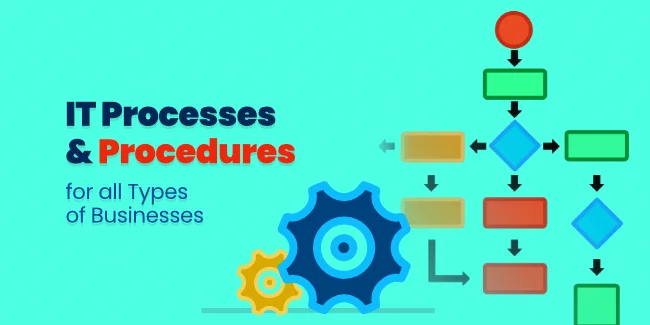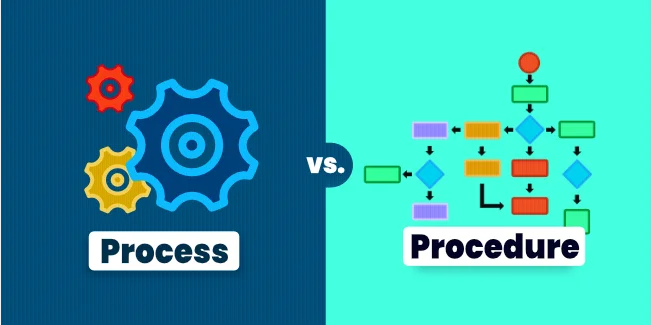IT Processes & Procedures for all Types of Businesses

Every business owner dreams of growing their business. However, the development of every company is associated with difficulties worth preparing for. The increased number of employees, data, orders, and various projects can throw the company into chaos. To prevent this, companies introduce processes and procedures into their organizations that not only help to control the functioning of the company but also have a real impact on the productivity and business results of the entire organization.
IT processes are one of the most critical processes in any company, regardless of whether we are talking about a software development company or a jewelry design company. Therefore, it is crucial to understand the IT process and how it enables companies to create successful products and gain a market advantage.
What is the Difference between a Process and a Procedure?

Processes and procedures are concepts that scare some business owners. Completely unnecessary because processes and procedures allow you to streamline work and control chaos, which is often a distinguishing feature of companies starting to develop. Control over all aspects of the company's operation introduces order and predictability and gives excellent comfort at work. Your employees can focus on crucial tasks, not on figuring out the best path to get things done.
It is worth remembering, however, that although the terms IT processes and IT procedures are often used interchangeably, they have slightly different meanings.
An IT process is a series of related activities or tasks that solve a specific problem or achieve a specific result. This effect can be a product or service, but also an effect within the company.
On the other hand, a procedure is a set way of carrying out a process. It describes the procedure that should be systematically followed when performing repeated process activities to achieve the intended goals.
Therefore, in this article, we will focus mainly on IT processes.
What are IT Processes?
The IT department is a key department in every company. Regardless of what your company does, you must have a secure IT infrastructure because the existence of your business depends on it.
IT systems not only provide data security and device management but can also revolutionize how the entire company operates, from streamlining business processes, through operations management, to data security.
Some IT processes are categorized as business support systems because they form the basis for core sales, marketing, and manufacturing activities. However, a considerable part of IT processes is crucial for the functioning of companies because, as part of the business strategy, IT departments create products for business, work on software development and ensure data security.
Exemplary IT Processes
IT Processes is a broad field that consists of various workflows, tasks, and functions. To ensure consistent results and to facilitate the measurement of performance levels, these processes are usually standardized. IT procedures can be divided into three classifications: service request management, IT operations, and software development.
-
Service Request Management
IT teams are constantly managing various service requests, from hardware issues, through service management, access management, and security threats, to asset management. These types of tasks can be grouped under the umbrella term IT Service Management (ITSM).
IT teams are often inundated with tickets that require quick responses, so it's essential to have a structured ticket management system that guarantees fast and accurate response times. By streamlining the workflow process, IT staff can quickly handle incoming requests. Thanks to this, they avoid situations that could lead to a threat to data security or reduce productivity.
IT teams must also manage processes impacting the company's day-to-day operations. These are called operations processes. They are characterized by the fact that they are usually repetitive and routine and can occur at regular intervals or according to a schedule.
The most typical operations processes include IT asset management, security, and configuration management.

Software development issues are essential to any business. Whether handled by a professional software development company or an internal IT department, software development is a process that should follow the software development life cycle. Suppose a project concerning, for example, the creation of a mobile application takes place outside the framework of established processes and procedures. In that case, the chance of success is slim.
Why are IT Processes and Procedures Critical?
Processes and procedures are essential in every area of the company's operation. Still, it is hard to resist the impression that IT processes are crucial, as they often determine the development and even survival of the company. Many aspects related to the functioning of any company are based on technology: from office equipment to specialized software. That is why the IT department needs to have transparent processes and operating procedures, because only in this way will it be able to ensure data security and high quality of work.
In addition, it is worth remembering that IT processes are not the only processes in the company. They often intersect with processes that take place in other departments. It means that the company processes must be consistent, cooperate, and not be mutually exclusive. It is the only way to effectively organize current work and focus on critical projects for the company.
IT processes also affect the company's functioning (by improving its productivity and efficiency) and its financial results (saving the company unnecessary expenses and, for example, accelerating the production process). However, it depends on how well the company processes are refined and implemented.
How to Manage and Improve IT Processes?

IT processes significantly impact a company's success, from performance to customer satisfaction to risk management. To correctly manage and improve processes, the best available practices developed by other companies should be used.
It would be best if you did everything to ensure that the software you create is written with relatively simple code, without unnecessary frills that do not add much to the functionality. Such a simple code not only allows for faster errors but also makes it possible for another programmer to take over the task of continuing this code without the need for many hours of introducing the topic.
-
Update IT Processes Regularly
All processes and procedures should be updated on an ongoing basis and adapted to the changing realities of the company's operation. If they don't, they quickly become obsolete and no longer respond to their goals. Each company changes, so internal processes and procedures should also be adapted to the new realities.
-
Remember about Automation
By leveraging automation, IT teams can streamline their processes and increase efficiency. Automation not only reduces the amount of manual work required, but it also eliminates the possibility of making mistakes - allowing for greater precision and accuracy in organizational tasks. Therefore, try to introduce automation wherever possible, especially for repetitive tasks that require manual work.
-
Streamline your Request Management System
IT teams receive a massive number of requests that range from serious issues to highly trivial issues. To maintain a high productivity level while prioritizing matters critical to data security and the company's proper functioning, it is crucial to have an efficient request management system.
Requests must be standardized regarding what is required and how it is communicated. In addition, requesters must be able to check their cases' current status to prevent unnecessary e-mails or phone calls. A streamlined request management system will improve the functioning of the entire company and will force it to deal with critical issues first.
Process mapping can be a powerful tool to help teams understand the intricacies of how processes should work and identify areas that may need optimization.
IT teams should map all their processes. It will ensure consistency, provide a source of knowledge for new hires, and offer an additional reference point for managers or external consultants who need more knowledge on building processes.

As the company grows, so do the number of departments and the number of people responsible for managing teams. The amount of information and data is also increasing, and thus their effective transfer is difficult. Silos are created that hinder the functioning of the organization. Silos are not specific departments and teams but rather how people work and communicate with each other. Misunderstandings, limited data transfer, and isolation of individual groups are the first signs of silos. IT departments understand the problems with silos very well because they deal with them daily. Silos lead to frustration, delays, and a lack of focus on priorities. Therefore, appropriate processes and procedures will allow you to control it.
Summary
IT processes and procedures help improve the functioning of the entire company and affect the greater efficiency of business operations. A comprehensive review of current procedures and processes in your company is necessary to introduce or improve existing ones. Thanks to this, you will discover which areas only need improvement and which require a completely new approach. As a rule, introducing changes causes excellent employee discomfort, but it is temporary. When your employees notice that procedures facilitate their work and increase efficiency, they will become very involved in their creation and improvement.
If you want to find out how IT processes and procedures have helped us create successful products for years, make an appointment for a free consultation with our specialists.